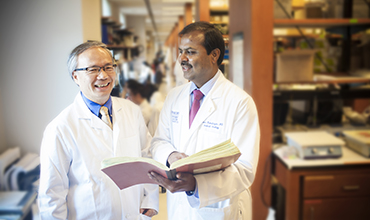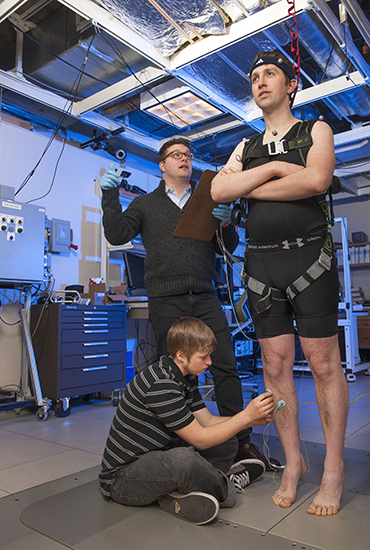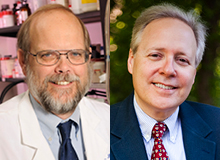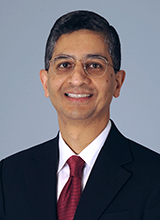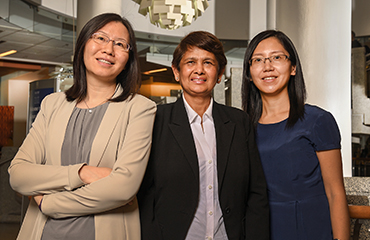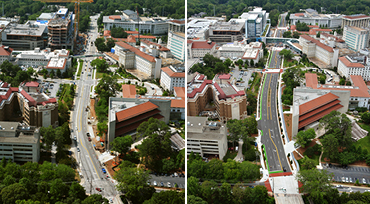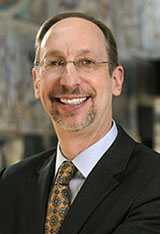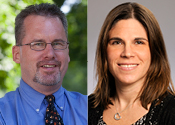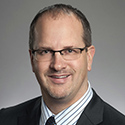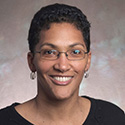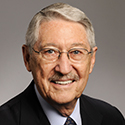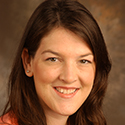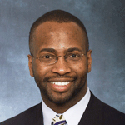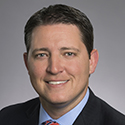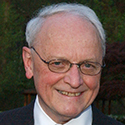
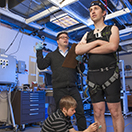
$51M renewal, name change for ACTSI |
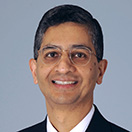
New dean and chief academic officer |
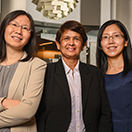
Trio in biostatistics |
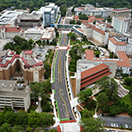
Clifton Streetscape almost complete |
|||||
| September 26, 2017 | ||||||||||||||
Research funding for FY 2017 totals record $628 million
Emory's research funding from external funding agencies totaled $628 million for fiscal year 2016-2017. This marks the eighth consecutive year that research funding has exceeded $500 million. With an increase from $574.6 million in FY 2016, this total is the largest in Emory’s history. Federal agencies awarded $384 million, or more than 61% of the total, led by the NIH, with $320 million in awards. NIH funding represented more than 83% of total federal dollars awarded to Emory. "Research funding at Emory has continued on a strong upward trajectory over the past decade due to the hard work of our dedicated research faculty, trainees, and administrative staff and the enthusiastic support for research from Emory's leadership,” says David Stephens, WHSC VP for research. Researchers in the WHSC received more than $584.8 million in FY 2017, or more than 93% of the university total, with $353.7 million in federal funding, including $307.7 million from the NIH. The medical school received $355.7 million, public health received $131.7 million, Yerkes received $79 million, and nursing received $15 million. Read more. ACTSI broadens focus, becomes Georgia CTSA
With a five-year, $51-million renewal grant from the NIH, the Atlanta Clinical and Translational Science Institute (ACTSI) adds University of Georgia as its fourth academic partner (along with Emory, Morehouse School of Medicine, and Georgia Tech). This addition reflects a new statewide focus and comes with a name change from ACTSI to Georgia Clinical and Translational Science Alliance, or Georgia CTSA. The Emory-led Georgia CTSA is one of 64 such alliances at major academic medical centers across the country and is the only CTSA in the state. The award will fund cores focused on improving quality, efficiency, and collaboration of the research process; provide consultative support and new tools in informatics and biostatistics; and pilot funding for new research projects and training and workforce development. The ACTSI was created 10 years ago to support clinical and translational research, including educating scholars and fostering academic-industry partnerships in clinical investigation. The Georgia CTSA inherits the ACTSI's longstanding collaborations with Grady Hospital, Children's Healthcare of Atlanta, Atlanta VA Medical Center, Georgia Research Alliance, Georgia Bio, and multiple community medical groups throughout the state.
The Georgia CTSA has five principal investigators, including Robert Taylor and Henry Blumberg from Emory, Elizabeth Ofili from Morehouse School of Medicine, Andres Garcia from Georgia Tech, and Bradley Phillips from UGA. Read more. Note: This new grant comes in Emory's 2018 fiscal year and is not part of Emory's $628 million research total for FY 2017, reported above. New medical school dean and chief academic officer for Emory Healthcare
Following the culmination of a nearly year-long national search, Vikas P. Sukhatme, MD, ScD, has been appointed the new dean of Emory School of Medicine. He also will serve as chief academic officer (CAO) of Emory Healthcare and as Woodruff Professor. He joins Emory on Nov. 1. Sukhatme succeeds David Stephens, who has served as interim dean and will continue his roles as VP for research in the WHSC and as chair of the department of medicine in the medical school. Sukhatme is currently CAO and Harvard faculty dean for academic programs at Beth Israel Deaconess Medical Center (BIDMC) in Boston and the Victor J. Aresty Professor of Medicine at Harvard Medical School. Sukhatme was born in India and raised in Rome. He completed a doctorate (ScD) in theoretical physics at MIT and received an MD from Harvard in the Harvard-MIT program in health sciences and technology. Following his residency in medicine and a clinical fellowship in nephrology at Massachusetts General Hospital, he spent two years at Stanford in immunology research. His first faculty appointment was at the University of Chicago, where he was also an assistant investigator of the Howard Hughes Medical Institute. In 1992 he moved to Harvard and BIDMC as chief of the renal division, and he subsequently received an appointment in the hematology-oncology division. He is the founding chief of the interdisciplinary medicine and biotechnology division at BIDMC. For eight years, he has been the CAO and Harvard faculty dean for academic programs at BIDMC. Sukhatme's research spans numerous areas of medicine in both fundamental science and clinical care. He has more than 200 scientific publications that have been cited more than 31,000 times. His longstanding interest in cancer currently centers on tumor metabolism and tumor immunology and on outside-the-box approaches for treating advanced cancer. He has conducted studies on genes important in kidney cancer and polycystic kidney disease. Sukhatme's laboratory played a key role in the discovery of the cause of preeclampsia. His research also has provided insights into how blood vessels leak in patients with severe infections and on how new vessels form to feed growing tumors. He has elucidated mechanisms by which statins can cause muscle damage. Sukhatme is known to be equally passionate about teaching medicine and educating communities outside of medical school. He initiated a course to bring MD/PhD students up to speed as they returned to the clinic after their graduate studies, as well as a mini-medical school series for the general public, and one for industry scientists highlighting unsolved clinical problems. Sukhatme also is an entrepreneur, having co-founded several biotechnology companies based on discoveries from his laboratory. Along with his wife, Vidula Sukhatme, he is co-founder of a not-for-profit organization, GlobalCures, to conduct clinical trials on promising therapies for cancer not being pursued for lack of profitability. Announcement of Sukhatme's appointment was made jointly by President Sterk, EVPHA Lewin, and Provost McBride. Read more. Trio in biostats: "Role models for us all"
Long-lived collaborations in academia are rare, and successful female researchers in statistical and math sciences are far from commonplace. So the trio of female scientific collaborators in the Rollins Department of Biostatistics and Bioinformatics is something of a phenomenon. Biostatisticians Amita Manatunga, Limin Peng, and Ying Guo have been working together for more than a decade, publishing eight to 10 papers a year, each taking turns as lead author. They are frequent presenters at national and international conferences, and they have developed statistical software that is now publicly available. "These are three very strong individual scientists, but when they work together, they are particularly productive," says Lance Waller, chair of the department. "Their joint work is a role model for the rest of us." Now they are trying to develop new statistical methods that could allow them to identify neuroimaging or biologic biomarkers corresponding with the different classes as well as with other traditional clinical scales of mental disorders. "Bringing these different types of data together poses a lot of statistical challenges," says Peng, in a massive understatement. The three scientists each count their collaboration as a career highlight and credit its success to their different areas of expertise. "We each bring different skills to the table," says Manatunga, who has mentored both Peng and Guo. "Limin has a strong mathematical background, and she brings a very sophisticated knowledge of mathematical theory. Ying brings strong bioimaging expertise. And I have a long background in working with a variety of psychiatrists studying mental health issues. We need all three of us to succeed in the complex problems we are facing." Beyond their areas of expertise, the three simply enjoy working together. "We formed this group very naturally," says Guo. "We are friends personally, good colleagues, and we share similar interests. We have a very good chemistry. I’d say we have a pretty unique group."—Martha McKenzie Clifton Streetscape project almost finished
The Clifton Streetscape project, which began in June 2016, is nearing completion and has brought dramatic changes to improve access, pedestrian safety, and aesthetics along Clifton Road. This project focused on several key issues. The roadway was badly in need of repair and repaving and needed to be widened so that travel lanes met current codes. A right-hand turn lane was constructed at the intersection of Clifton and North Decatur roads, and a new entrance to campus was constructed at Healthgate Drive. For pedestrians, new and wider sidewalks were put in place, with pedestrians now separated from traffic by a five-foot planted strip. Trees line both sides of the road, three planted medians give the landscape a consistent appearance, and the road now has LED lighting. Other key elements of the project include four distinctive concrete intersections and crosswalks to alert motorists to major pedestrian crossing points. A green dedicated bike lane was included on the east side of Clifton Road, and a separate bike lane was constructed from Eagle Row to Woodruff Circle. A guiding principle over the duration of this project, says project manager Al Herzog, was careful coordination to ensure that this work did not interfere with or delay completion of the new hospital tower. The streetscape project is expected to be finished next month, says Herzog. Clifton Streetscape facts: • 8,000 SF of sidewalks added to create a safer, wider walking surface for pedestrians • Nearly 4 million pounds of stone base course used to correct failed sections of roadway • 25,000 SF of new roadway surface constructed, including a right turn lane at North Decatur Road, wider travel lanes, and Healthgate Drive • More than 1,000 cubic yards of concrete poured for four concrete intersections, new curb and gutter, and new sidewalks • 4,000 linear feet of new curb and gutter added along the entire corridor • Size of travel lanes increased to comply with Department of Transportation standards • Dedicated bicycle lane constructed on east side of Clifton Road and dedicated off-road bicycle lane constructed from Eagle Row to Woodruff Circle • 113 trees planted along Clifton Road • Three planted medians constructed in Clifton Road • 70 new LED street lights installed to replace outdated systems on wooden utility poles • Overhead electrical, phone, and cable TV systems replaced with underground systems |
| From the Executive VP
Thanks to all who brought EUH Tower project to fruition
Three weeks ago, cancer patient Crystal McCollum became the first inpatient of the new Emory University Hospital (EUH) Tower. A decade in the making, this 450,000-square-foot, nine-story, $400 million, state-of-the-art facility has 232 patient rooms, including 40 critical care beds. The tower brings EUH to 733 beds, allowing us to best meet the needs of our patients and their families. I'm so grateful to the hundreds of nurses, physicians, administrators, staff, and patient and family advisers who participated in the design and testing of the new tower. Their valuable input has resulted in a facility that will foster efficient care delivery, a more comfortable stay for our patients, and many conveniences for family members and visitors. Thanks also to Bryce Gartland, Bob Bachman, and David Pugh, among others, who worked tirelessly for many years to see this project to fruition. And, as always, deep appreciation goes to the Woodruff Foundation, which provided $210 million to help fund the construction. The Emory University Hospital Tower helps us fulfill Robert W. Woodruff's vision of offering health care in Atlanta that is among the best available anywhere in the country. Please direct questions and comments to evphafeedback@emory.edu
Autism center funding renewed
The Marcus Autism Center, directed by Ami Klin, received renewal of its Autism Center of Excellence designation from the NIH, including an $11 million, five-year grant. Read more. Full continued accreditation
AAALAC International has conferred continued full accreditation to Emory's Division of Animal Resources (DAR) and to Yerkes until 2020. Yerkes led the way at Emory in first achieving AAALAC accreditation in 1984, followed by the rest of the university in 1992. Both have since been continuously accredited by AAALAC. Michael Huerkamp is DAR director and Emory's Institutional contact with AAALAC. Joyce Cohen is associate director for animal resources at Yerkes and led the effort for Yerkes' reaccreditation. Read more. Precision medicine network
The NIH recently chose Emory to join a national effort with more than 25 collaborating institutions charged with advancing research into precision medicine. The program aims to gather data to be used for studies on a variety of health conditions to learn more about the impact of individual differences in lifestyle, environment, and biological makeup. Michael Zwick (human genetics) is leading Emory's participation. Read more. Report on opioid epidemic
Anne Marie McKenzie-Brown (anesthesiology), director of the Emory Pain Center at EUH Midtown, is co-author of a report recently released by the National Academies of Sciences, Engineering and Medicine on strategies to deal with the opioid epidemic. Read more. Nursing school recognized by NLN
The nursing school was designated a center of excellence by the National League for Nursing (NLN). Angela Amar, associate dean for undergraduate education, led the school’s effort to earn this designation. Specifically, the school was recognized for enhancing student learning and professional development, one of four areas recognized by the NLN each year. Six other nursing schools were honored in the same category. Read more. New rankings Emory Healthcare's physician group practices were ranked second in the nation among participating academic medical centers by Vizient, Inc for access, capacity management and throughput, quality and efficiency, continuum of care, and equity. Read more. For the sixth consecutive year, U.S. News & World Report ranked Emory University Hospital No. 1 in Georgia and Atlanta. Emory Saint Joseph's Hospital ranked No. 2 in both Georgia and Atlanta, while EUH Midtown ranked No. 11 in Georgia and No. 6 in Atlanta. See more rankings. EHC adds nine primary care locations Emory Healthcare recently opened nine new primary care clinics throughout metro Atlanta and expanded the Emory Clinic location at Midtown with two new doctors and a nurse practitioner. Read more. New stem cell core
The Emory Stem Cell Core, led by Gary Bassell and Megan Merritt-Garza, opened this month in the Whitehead building, Room 429, as the newest member of the Emory Integrated Core Facilities. More info. Notable
Georgia Research Alliance Eminent Scholar Max Cooper (pathology) recently received two major honors in recognition of his fundamental contributions to immunology. He was inducted into the French Academy of Science Institut de France and also was elected as a fellow of the Royal Society.
Dabney Evans (global health) received the American Public Health Association's 2017 Mid-Career Award in International Health. Read more.
Dorothy Jordan is one of five nursing faculty recently named fellows of the American Academy of Nursing. The others include Elizabeth Downes, Lisa Thompson, Barbara Tomczyk, and Sharon Vanairsdale. Read more. Vanairsdale also was recently inducted into the Academy of Emergency Nursing.
Marilyn Margolis, CEO of Emory Johns Creek Hospital, has been elected as the new chair of the Johns Creek Chamber of Commerce. Read more.
Charles Moore (otolaryngology) received the Georgia Hospital Association's Distinguished Service Award.
Daniel Owens, CEO of Emory University Hospital Midtown, has been elected to the Georgia Hospital Association Board of Trustees. Read more.
Erin Mitchell Richeson has been appointed director of Organizational Equity and Inclusion in the medical school.
Sheila Sanders has been named CIO for Emory Healthcare.
Ken Walker (general medicine) received the 2017 Leadership award from the Georgia Chapter of the American College of Physicians. Events
Oct 5: Magician-scientist Stuart Zola (also former Emory interim provost and Yerkes director) will deliver the 34th annual Weens lecture, "Why Don't You See Things My Way?" 5:00 p.m. reception, 6:15 lecture, WHSCAB plaza and auditorium.
Oct 14: 7th annual Winship Win the Fight 5K. Atlanta Hawks star Dominique Wilkins will serve as grand marshal. More info. Oct 18: Learning from Ebola and the Future U.S. Role in Global Health. 2:00-5:00 p.m., Klamon Room, CNR building, RSPH. Reception to follow. More info. Oct 26: Healthcare Innovation Symposium XX: Health Services Research. More info. |

